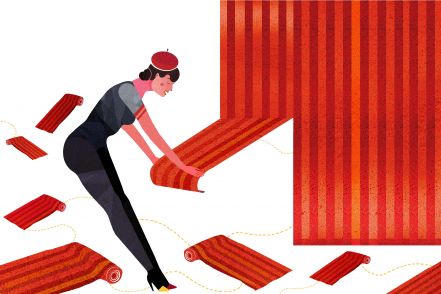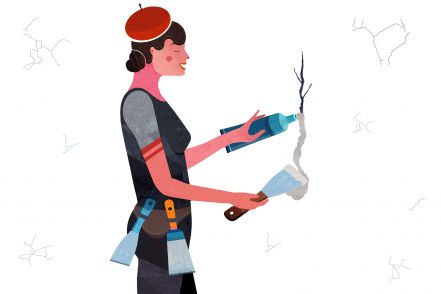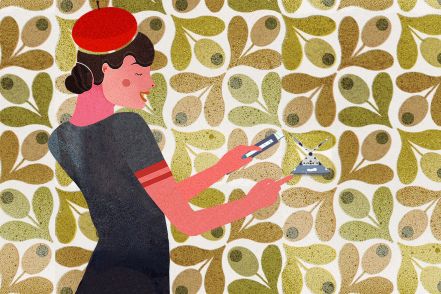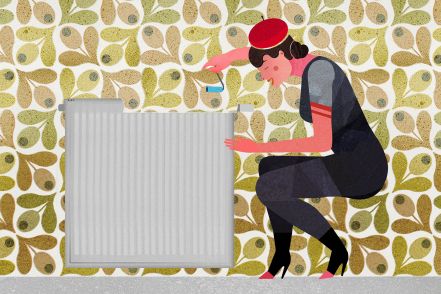What can I do to prevent bubbles and blisters?

1Basics regarding blisters and bubbles created during wallpapering
Don't despair when blisters appear during wallpapering! These bubbles can have a number of reasons. Often, they are caused by surplus wallpaper paste or air bubbles under the paper, but you can usually get rid off them very easily.
Reasons for blisters in paper-based wallpaper
Paper is made of wood, and paper-based wall materials consists of wood fibres, which will react to humidity. As we all know, wood swells when in contact with water, and the same is true for the wood fibres contained in paper-based wallpaper. When the paste is applied to a length of wallpaper, it expands in both length and width. This is why the correct soaking time is of such great significance. The wallpaper needs to be given sufficient time to absorb the liquid - and consequently to expand.
If the soaking time is insufficient, the paper will expand on the wall, leading to “creased” air bubbles. The soaking time stated on the packaging of the paste for paper-based wallpapers is based on experience/empirical values and should be observed for each individual length of wallpaper.
The following instructions will explain how bubbles are created, and how you can remove them.
The following instructions will explain how to get rid of blisters and bubbles.
Further reasons for blistering
Blisters are created when the underground surface is very absorbent and "soaks up" the wallpaper paste before it has a chance to develop its adhesive quality. A sealed surface (e.g. impermeable layers of paint or lacquer) can be problematic, too, as it will not absorb any liquids, which means that the paste cannot stick to the wall. Sanded or rough surfaces also hamper adhesion. As a general rule, take time preparing the surface properly in order to prevent blisters and bubbles as much as possible.
Using inappropriate paste or the wrong mixing ratio of water and powder can lead to decreased adhesive strength and thus to potential blisters. Always apply the wallpaper paste evenly on paper-based wallpaper or (for non-woven varieties) to the wall. Be sure not to apply it too thickly or too thinly, as both will lead to decreased adhesion. As a result, blisters can appear in areas where too much paste was used, or areas which were too dry.
The way the wallpaper dries is also an important factor. A draft, temperatures that are too high or too low, or high humidity, can lead to blisters. Ideally, the room temperature should be between 10 and 16 degrees Celsius. Even if you don't have a hygrometer, high air humidity can be indicated by a damp, cool room climate. But constant ventilation (by opening windows and doors) is just as harmful as a draft. You should just open the windows at regular intervals, for about 10 minutes, so that the humid air can escape.

2 Brush fresh blisters towards the edge
Individual bigger blisters can be dealt with by moving them to the side with a clean, dry, soft cloth, or clean fingers. Excessive amounts of paste that escape from the edges of the wallpaper can be removed with a slightly damp, clean cloth.
If, like our wallpaper girl, you find yourselffacing a number of smaller, creased air bubbles, use your wallpapering brush to smooth them out. A wallpapering or seam roller is a very handy tool to get rid of bubbles, but make sure it is covered in soft foamed material. If you use a plastic roller, you need to put some white paper between the roller and the wall to avoid damaging the wallpaper surface (especially with structured wallpapers).
But if the blisters are simply too persistent

Don't use brute force! You could seriously damage the wallpaper. We will show you additional methods under section 3.

3 Subsequent removal of blisters using a paste syringe
Using a wallpaper syringe (or a bottle of wallpaper paste with a pointed nozzle) you can remove blisters by applying paste underneath the bubble. Paste nozzles (or "syringes") are special wallpapering tools - they don't look much different from medical syringes, but they are not sterile. They are designed to easily apply the gel-like paste.
You can buy them in any good wallpaper or DIY shop. Make sure you get a high-quality model with a hollow needle made of metal. You can also get these syringes with a plastic nozzle, but they are unsuitable for thicker wallpapers.
One final thought:
Most blisters and bubbles disappear after the wallpaper has had time to dry, so don't worry too much. After all, you now know all the tips and tricks as to how to get rid of them, just in case.
Draw up a bit of wallpaper paste into the syringe. Then penetrate the bubble with the pointed needle and carefully squeeze the paste underneath the paper. Now spread the paste throughout the whole area of the blister. Don't forget the soaking time for paper-based wallpapers before smoothing out the bubble towards the "injection point". You might need to penetrate the bubble in more than one place, depending on its size, in order to reach all dry areas.
For large bubbles, you should use a cutter knife. Cut the blister in the shape of a cross. Now apply some paste to the back of the wallpaper and leave it to soak. After the soaking time, press the corners down.















